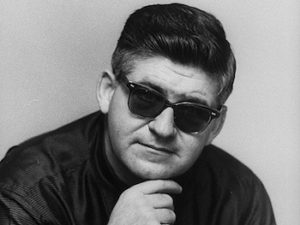
John Howard Griffin
On this date in 1920, John Griffin, a white-American writer and musicologist, was born.
John Howard Griffin was born in Dallas, TX. His mother was a classically trained pianist who taught for 30 years in the Fort Worth area, and his father was an Irish tenor and a radio personality. His family influenced Griffin's lifelong love for both music and literature. He attended high school in Fort Worth until he left the United States at 15 for classical education. He completed studies in French and literature at the University of Poitiers and studied medicine at the École de Médecine. He interned at the Asylum of Tours, conducting experiments in the use of music in therapy for the criminally insane.
He received certificates of musical study from the Conservatoire de Fontainebleau. Griffin was a musicologist specializing in medieval music, especially the Gregorian chant, for which he received certificates of study from the Benedictines at the Abbey of Solemnes in France. At age 19, he worked as a medic in the French Resistance army, evacuating Austrian Jews safely from the Nazis. He served in the United States Army Air Corps in the South Seas.
He was decorated for bravery and was disabled in the fighting during World War II, losing his sight from 1946 until 1957. During his 12 years of blindness, he wrote five novels (three unpublished) and began a journal in 1950 that had reached 20 volumes at the time of his death. Griffin's books include “The Devil Rides Outside” (1952); “Nuni” (1956); “Land of the High Sky” (1959), the story of the Llano Estacadoqv region, and his only book on Texas “The Church and the Black Man” (1969); and “A Time to be Human” (1977).
He published photography in “Jacques Maritain: Homage in Words and Pictures” (1974) and “Twelve Photographic Portraits” (1973) and wrote several books on “Thomas Merton: A Hidden Wholeness” (1970), “The Hermitage Journals” (1981), and “Follow the Ecstasy: Thomas Merton, the Hermitage Years, 1965-1968” (1983).
Griffin also wrote syndicated columns for the International News Service and King Features from 1957 until 1960. He is best remembered for “Black Like Me” (1961), still in print in 1990 and translated into 13 languages. For this book, Griffin assumed the identity of an itinerant Black man by chemically altering his skin color and shaving his head. He visited several racially segregated states for six weeks in 1959. At first, George Levitan, a Texas publisher, thought his idea was unwise but changed his mind. His magazine, Sepia Magazine, financed the project in exchange for the right to print the account first as a series of articles.
He initially recounted his adventure in a series of installments printed in Sepia in 1960; a year later, his book version became a best seller. After becoming the target of local protests against “Black Like Me,” Griffin moved with his family to Mexico, where he remained for about nine months before moving to Fort Worth. He was a member of the American Society of Magazine Photographers, the Royal Academy of Photographers (Great Britain), and the musical fraternity Phi Mu Alpha. He was a lifelong Democrat and co-recipient with John F. Kennedy of the Pope John XXIII Pacem in Terris Award. He received the Saturday Review Anisfield Wolf Award for “Black Like Me” in 1962, the Christian Culture Series Award, and the National Council of Negro Women's Award.
John Griffin, probably most famous for assuming the identity of a Black man in the late 1950s and early ‘60s, touring six segregated states, and writing a book about it, died in Fort Worth on September 9, 1980.